COLUMBIA, MO — I am attending a half-day symposium here at the Reynolds Journalism Institute at the University of Missouri’s journalism school, this time a meeting of the “Digital Publishing Alliance,” a group of newspapers and tech folks who are looking at how newspaper content might work on various e-readers like the Amazon Kindle. The timing of the meeting is interesting, coming on the day that Amazon and the New York Times are having a press conference, most likely to announce a new wide-screen Kindle DX for magazine, newspaper and textbook content.
Mizzou Pushing New Media?
But before I get into that subject and live-blogging of the meeting, I want to share the experience I’ve had on the Missouri campus. I went to journalism school here in the late ’80s, and at the time the school had an early Mac lab, which seemed to be a big deal then. Now, they have the new RJI building with a “futures lab” and some great convergence studios and multimedia setups. I got to sit in on some “capstone classes” where students were working on real-world projects as diverse as setting up local online health portals, doing online marketing plans for e-commerce sites, and setting up collaborations among public radio stations in mid-Missouri.
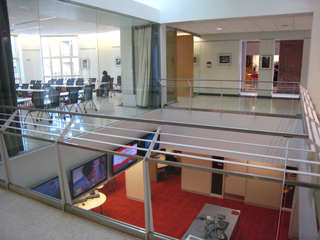
But my nagging feeling was that I was being given the dog-and-pony show, being in a room with the best and brightest and most engaged students, and hanging out with the professors and faculty who “got it.” What about the intro classes and the students who felt like they weren’t getting the education they needed in the new age of multimedia, citizen journalism, blogging and podcasting?
I convened an informal focus group of J-school and pre-J-school Mizzou students, and gave them a forum to gripe about what might be going wrong in their own classes. While they did complain — as all students would about anything when given the forum — it was about having too much emphasis on new media. One student said he didn’t want to have to learn so many different skills — video editing, writing, voiceover, etc. — in his convergence sequence. It seemed to be too much and he was overwhelmed. I had to break it to him: that’s what most new jobs will require now.
Others did have legitimate complaints that they weren’t being taught enough about getting jobs, creating portfolios and pitching prospective editors and producers. But that was counterbalanced by one broadcast sequence student who said they had been prepping for getting a job right at the start of journalism school, and he said he had one class focused specifically on how to get freelance work. “People joke that the journalism school is like a trade school because it’s so focused on getting jobs,” he said. I think that’s actually a good thing right now.
But most telling, the broadcast student mentioned professors like Jennifer Reeves, who he said was getting under their skin talking about digital media, social media and Twittering like mad. While the students were a bit mixed on using Twitter, one admitted that he had used it to communicate with key journalists in the industry and it dawned on them how important it could be to make connections for future internships or jobs. I have to say that if the Mizzou students are largely complaining about there being too much new media pushed down their throats in school, that’s also a good thing. Or at least, a different thing compared to most schools I visit or hear from.
If you are a Mizzou journalism student or teacher, be sure to use the comments to share your own experiences (good or bad) at the school…
Now back to the meeting on e-publishing…
Next Generation of E-Readers
Roger Fidler, who founded the Digital Publishing Alliance, and is based at RJI at Missouri, gave a quick overview of the e-reader industry and previewed Amazon’s upcoming announcement, not yet official, of the new wider screen DX e-reader.
Sarah Geata, Plastic Logic senior director of content development: We don’t have a finished product out in the marketplace yet. We were founded in 2000, and have 73 patents filed with 20 granted. We have raised more than $200 million. The founders believe strongly in the technology. There’s no silicon or glass in our products, only plastic. We built a factory in Dresden, Germany to manufacture the screen. It’s a touch screen device with E-Ink, we build it in a huge clean room and the materials are put together in China. We are based in Mountain View, Calif., to be headquartered in Silicon Valley.
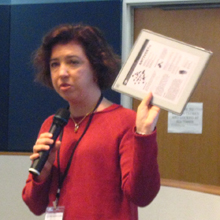
What are we bringing to market? [Shows prototype.] This is a little heavier than what the finished product will be. There’s just one button on it, and it connects to your computer USB port. It has batteries, WiFi module and other items. It’s great for newspapers but it’s not for taking the look of a newspaper and shrinking it down. It’s great for showing advertising. Your business has subscription revenues and ads and we want to deliver that for you [newspapers companies]. We want for you to have the ad business.
These are durable and don’t break, like glass. Compared to the i-Rex devices, ours will only be 12 ounces. We are a touch screen similar to the iPhone. Swipe to turn a page, there will be tool bars that can pop up or be hidden. It will have WiFi, USB connection and a Bluetooth. We support PDF, ePub and MS Office. We are targeting business traveler, you can annotate documents on it. Half the content on here might be user-generated content, work content, and also newspapers, journals, magazines and books. Color screens are important.
The “Day in the Life” of the reader:
> At night, it’s plugged into a PC to charge and sync.
> Subscriptions delivered overnight.
> Reads it with coffee in morning.
> Annotates marketing document.
> Checks travel schedule and hops out.
> Reads magazine on the road.
When plugged in, the device can upload email to it. E-Ink doesn’t do color yet, but they have a prototype for it. My boss saw it and said it wasn’t too bad. It took years for many devices to get to color screens, with 4 years for the iPod before it was a color iPhone. We will show off our interface at the D conference later this month.
Q: WiFi included?
It will be built in. Kindle set the standard making it transparent.
Q: Online? Will there be a web browser?
Not right now. It’s about not being interrupted. It’s a reading device. There won’t be email on this or a web browser, but people can shop for papers, subscriptions directly, without putting in a credit card. Why not web browsing? The technology works like an Etch-a-Sketch that has to be cleared each time, so having Flash running would be a bad experience. Eventually you’ll get to video frame rate of 30 frames per second and can do web browsing. I think it will evolve over time.
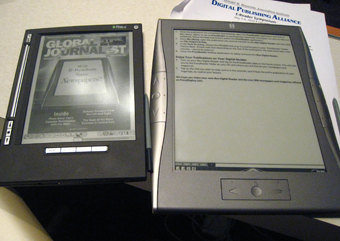
We plan to announce in January 2010, and it will be U.S. only at the start. But we are better known in Europe than here. We get inquiries from potential partners in Europe a lot. We can’t say the price yet, it will depend on manufacturing costs. Our factory can do hundreds of thousands of units, and we own land next to our factory so can expand potentially.
We have limited numbers of partners, including the Detroit Free Press, which will get early units before we ship next year.
Q: What’s the capacity of units?
It will probably be 6 GB of data just for document storage. There is other memory for applications. We have partnerships with LibreDigital and Ingram. We want to have 25 to 50 newspapers when we launch, but realistically it will be 3 to 5 newspapers at launch. That’s because we don’t just want a digital replica, but we want a different presentation of the news content, which means you have to re-lay out the format. So it will be more difficult to get more than a few ready to go. We are talking to magazine vendors and have a partership with Zinio, which has lots of magazines. We want it to be an open platform, so people can get whatever they want in the supported file formats and transfer it onto the readers.
NY Times Reader 2.0 Announcement
Jeremy Clark, senior experience manager at Adobe (speaking from California via teleconference): We are working with the New York Times and are going to release Times Reader 2.0, a desktop news reader application built on Adobe technology, to deliver content without a browser. It’s based on Adobe Air, to create real desktop apps without having to learn programming languges. It works the same on Mac, Windows and even Linux. We’ve been working on this with the NY Times to sync content in about 30 seconds and that info is cached locally, including text and graphics. It’s resizable and works on bigger or smaller screens and scales.
It’s similar to Adobe Flash and renders the text in columns that wrap, the pages are paginated so that an article that’s several pages long on a small screen will just be on one page on a larger screen. We have some interactive features, there’s video, news feeds, pictures, imagery from the articles, a graphical way to explore news. Plus there’s an interactive crossword puzzle.
James Dunn, NY Times marketing of subscription products: We had the Times Reader from Microsoft and it was an ongoing streaming of news. And it’s hard to see the daily news judgment of the Times. This new reader looks more like the newspaper. The content for each section mirrors the print product. We wanted to give it a website feel, so we have an ongoing feed at the bottom.
We did research with home delivery subscribers to find out what it was about print they liked. We have print subscribers paying $700 a year, so what are they willing to pay for? They like the serendipitous nature of print product. Arrow buttons let you turn pages, and navigate between sections. Crossword puzzle can be printed to look like print page. It’s coming out next week, and has the best of both worlds — print product and website.
Q: Pricing?
Two versions: Perpetually free version, and $3.45 a week will have full application and more sections. If you are a print subscriber, you get it all free. The free product will only have front section, Business Day and Most E-Mailed and Video, and an older crossword puzzle. All the other sections will be locked, and you can see intro text, and then a pay wall.
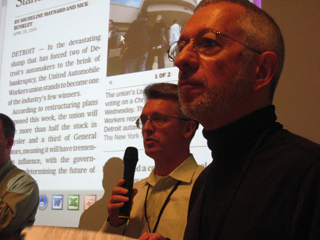
Ray Pearce, NYT: Key points of Amazon Kindle DX announcement: A lot of the rumors were accurate, the Kindle DX was announced as a large screen device with a 9.7 inch screen. In essence it is Kindle 2 on a large screen. The buttons are similar. The screen is 2 1/2 times larger, with 16 shades of gray, consistent with Kindle 2. They will partner with textbook publishers and doing test with 5 universities who will give students option of getting Kindle DX, there’s a new PDF reader. The Kindle DX comes with an auto-rotation feature like the iPhone if you turn it horizontally. Now can hold 3600 books, has more memory, 3.3GB.
From the newspaper standpoint, it will be a deal with the NY Times, Boston Globe and Washington Post so people can get a subsidized price with bundles of subscriptions. This will be a limited offer only for people who are print subscribers to the NYT who live outside the New York area.
Content Formats for E-Readers
Guy Tasaka, LibreDigital’s director of business development: It’s tough to follow two big announcements, the NYT Reader 2.0 and Amazon DX, but I’m going to talk about e-reader formats. We were founded as NewsStand in 1999 to do digital replicas with e-editions. I worked with Ray doing NY Times digital editions. It’s tough to sell paid content on the Kindle when you can get it free online, but what the Times is selling is portability.
HarperCollins came to us and wanted us to help protect their content, so we built a data warehouse for publishers’ content. When a Google search went in, results would be served, and publisher would be able to control the content, and could shut it off from Kindle and Amazon if they wanted. We want to take a version of our format and help publishers deliver a feed for content. The NY Times, HarperCollins are investors in us.
E-book sales have exploded, up 100% year-over-year. What kept e-books alive in middle years was housewives reading romance novels. At one point, 50% of sales were romance novels. In 2006, Sony jumped in and then Kindle, which accelerated growth. In 2008, ePub became industry standard. Just like when Blu-Ray became the standard, things took off. PDF is still there, but the industry needs an XML format. But yes, PDF is not falling off the table.
Economics of delivering a newspaper on Kindle:
> Avg. file size = 1.2MB
> Bandwidth cost = .12 cents MB
> Selling price = $13.99 month
> Monthly bandwidth cost = $4.32
That eats into monthly cost of serving content into Kindle. So Amazon is probably losing money on some of the lower cost publications it sells. This cost doesn’t even include advertising in the mix.
Pros and cons of PDFs: Pros is that they are everywhere, and you can control fonts, photos and layouts independent of the device. Cons are that text is static, speed, size and file created in post-processing.
Case for Newspaper Consortium for E-Readers
John Forcucci, IT director of business solutions for Boston Globe: I’m not speaking as a representative of the NY Times or Globe, this is my idea. I think we’re at a moment in time where we need to make some decisions and manage what our future will be. The newspaper industry could establish a brand new platform that doesn’t exist except for e-books on Amazon and Sony. What we can bring to the platform is our set of consumers. NY Times and Globe readers are so loyal, paying hundreds of dollars per year. They are valuable consumers.
Newspapers are a daily experience. When you buy a book, you might read it a few days out of the month. But anyone in the habit of being a newspaper reader will go every day to read the paper. The killer app of the e-reader is the E-Ink surface. It’s a more intimate experience that’s better than the disembodied web experience. There’s a sticky factor, people will read on this device for longer periods of time.
So what’s happening? There are standards all over the place and so many feeds to serve. So let’s say all these e-readers work out and launch and we all have separate deals, different revenue shares, and if you want to sell ads on all the platforms, you might need 4 different versions of that ad.
What if we had a consortium? What kind of power would we have? We could build a brand new ad platform. Do we want to control that? Of course. There are two levels, a national consortium… We look at business models, revenue shares, how do we achieve a newspaper experience on these devices? And maybe there’s a regional consortium that could talk to the national one. I could go to our arch-enemies, GateHouse and Community News, and say, “You can’t put out a feed in these devices, because you can’t afford it.” I think we should put small weeklies and dailies onto readers. People should be able to get all newspapers they want, all the books and magazines they want.
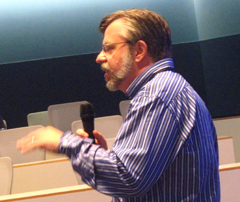
If I’m putting a device into the market, they would piggy-back onto that. If the subscription fee is very low, then the Globe would take a bigger share because we’re putting the platform out there. Then you can create regional metros, with an ad platform for the region. Think of it like cable TV. First I want to give the Globe subscriber the chance to bundle other pubs, like the SF Chronicle — they might have a kid living there or follow a team there — then geography melts away.
The other part of the consortium should be about standards, and they should be driven by the newspaper business. I won’t let the Globe do anything that doesn’t look like the Boston Globe — on all devices. The device makers have made this real, but we will benefit them if we establish a business for them, not only magazine and book market, but business documents, schools, and who knows what else. The i-Rex reader lets you annotate and take notes.
Forrester slide: Newspapers should take this market. I agree whole-heartedly. These ideas are not finalized. We need to facilitate a group of publishers to come together and figure out now: Does this make sense to do it and own it now? We can hook up with the controller of the ePub format. The complicated thing is coming up with a business model that works for makers like Plastic Logic and for newspapers. We don’t want to give it away. We now own trucks, printing presses and that platform, so how will we assume risk so that we are getting maximum revenues for our product.
Q: What about smaller players? How can we jointly make it work?
Forcucci: If you look at top newspapers, online there are millions of readers. We have an enormous market share. So there are some people who are interested in getting re-aggragated data that someone in Dayton, Ohio, might want. So we can build the critical number. Don’t go with 100,000 units, but with 1 million, which is an achievable goal. The price of these devices will go down and the value will improve.
Q: What about how much time and money people have, especially in tough times? Newspaper companies are betting the farm on the web. It’s free, we’re building audience there, that’s where the resources are going. This is something else. Please make the argument to the CEO at a newspaper why we should do this instead of print and web.
Forcucci: What’s the argument that works? Money. Boston.com has 5 million monthly viewers and most of them are in 2 times are less per week. We believe that we’re getting close to maxed out with web revenues, but it’s nowhere near the print revenue side and won’t get us close. We need another revenue stream. Given the Kindle’s success, many people believe we can create a new growth avenue for the newspapers.
Q: Do we lose interactivity with e-readers vs. on the web where people can interact and leave comments and watch video?
Forcucci: I think it can still work in tandem with the web. That’s a big fear among people. But the way people use the web is they check it out during lunch. But the e-reader can fit into the web use, with the web being more of a Long Tail.
Mark Glaser is executive editor of MediaShift and Idea Lab. He also writes the bi-weekly OPA Intelligence Report email newsletter for the Online Publishers Association. He lives in San Francisco with his son Julian. You can follow him on Twitter @mediatwit.
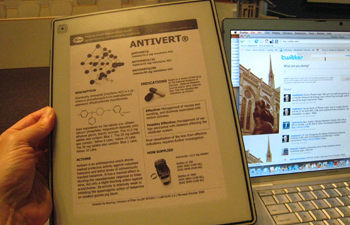

Nice post, Mark!
As one of the dogs or ponies who had the good pleasure of inviting Mark into our classroom — I have to say J-school isn’t much different from any other place grappling with changing technology and changing consumer wants and needs.
Some folks “get it” and some folks don’t. That includes students.
We have some students who are ready and able to become entrepreneurs. We have others who want guidance about portfolios when they are still working on the critical thinking about what constitutes a story. (Who, what, where, when why, how)
As faculty, we strive to keep the balance. And, while students need to know technical skills and often feel these are what will get them jobs — I try to reinforce that the skills need to be applied to high quality content. Without the underlying news gathering, all of the flashy videos, slideshows and even iPhone apps aren’t going to get our students lasting jobs as journalists.
Hi Lynda,
It was good meeting you at Mizzou and sitting in on your class. I like your attitude about teaching the new and the old, and you’re right that it is all about balancing that out. I guess there has been so much resistance among many j-school professors just to teach basic new media techniques in the past (and among students) that it’s nice to see that switched around a bit.
I am an entering freshman for the fall of 2009 at Mizzou, with plans on going into the convergence journalism. I enjoyed your article very much, and must say, that I am actually encouraged right now hearing that students are complaining that there is too much “new media”. One of the main reasons I chose to attend Mizzou is because it stresses the importance of new media and the diverse range of skills that are needed in today’s field of journalism. I often see the same resistance towards new technology in my own high school newsroom, especially when we were trying to start our website. I think a lot of student journalists (as well as working journalists) need to realize that this is the direction journalism is going in, and if they aren’t prepared for that, then maybe they should pick a different career.
All models of e-readers being touted today are inadequate devices that are still works in progress (for example, a double-page screen e-reader is a must for adequate advertisement delivery). As such, the majority of people are not going to pay $500 or more for them. The only way to get people to switch to e-readers right now is to offer an e-reader with each annual subscription. In other words, the e-reader cost has to be embedded in the price of subscription. At $500 or more an e-reader, that is simply not possible, except perhaps for the readers of Wall Street Journal.
So several things have to happen: first, an e-reader, as an embedded, dedicated device, does not have to have all the bells and whistles. The Plastic Logic Reader–a possible Kindle killer–in its standard configuration uses Windows CE, but why not Linux? That ought to save at least $20 to $30 in cost. So a stripped-down Plastic Logic Reader for newspaper adaptation should be much cheaper.
E-readers will continue to evolve rather quickly with steadily declining cost, but people are not going to keep upgrading e-readers every year in spite of their falling price, so embedding an e-reader in each annual subscription is the way to go. As for establishing an industry-wide consortium that will define all sorts of parameter, it will only hinder the rapid evolution of inexpensive e-readers. It would be more important to see an e-reader with a dual-page, letter-size display in color for $100 than try to define a single standard for ad format.
At any rate, newspaper publishers have to negotiate with e-reader manufacturers for the lowest cost versions of their e-readers that do the job. In this respect, some sort of consortium is desirable since it would have a greater collective bargaining power to reduce the cost of e-readers, but under no circumstance it should make an exclusive deal with a single e-reader supplier. That would be tantamount to calling for another Microsoft type monopoly.
Second, since it would not be financially feasible for periodical publishers to embed an e-reader for each annual subscription, the newspapers that are embedding e-readers with subscription must work closely with periodical publishers to enable magazine distribution via newspapers’ e-readers (why not books, too?–sans Amazon, that is); otherwise, magazines will be at the mercy of wolves like Amazon who would demand 60-70% cut on e-publications.
Third, since Congress is showing interest in helping newspaper industry right now, newspapers should ask Congress for some sort of tax break (or even “rebate”) on each annual subscription that includes an e-reader–a sort of tax credit for improving the e-publishing infrastructure. Why not? After all, Congress already approved nearly $20 billion in spending to improve the broadband Internet infrastructure.
Fourth, newspapers (and periodical publishers) need to create a sort of hybrid website between Amazon and Google News site that allows online readers to sample and buy (or subscribe to) the electronic version of newspapers and magazines. This means publishers also need to stop en masse providing freebies to Google and other news aggregators.
Naturally, such a venture does not have to depend on newspaper and magazine publishers to establish, but it should be able to offer some sort of volume discount on multiple subscriptions to readers (say, 10 different publications for the price of 8, etc.), as well as an easy way to drop a subscription to a publication and apply the new credit balance to subscribe to another publication. That usually means there should be a consorted effort on the part of the newspaper and periodical publishers to make it happen.
In addition, in order to facilitate impulse purchasing of a single issue of a paper or periodical, there should be a one-click purchase option available on such a venture (via an electronic token system, perhaps). In a nutshell, what the publishers need to do is to encourage the creation of electronic version of the newsstand, like the one we see, say, in a brick-and-mortar Barnes & Nobel bookstore.
Firth and foremost, one thing that ought to be clear to all newspaper and periodical publishers is that the wasteful practice of printing news on millions of tons of newsprint must come to an end; thus, the transition to e-readers is inevitable, logical, and environmentally sound. Consequently, they must embrace e-readers as their future.
I can go on, but the point here is that newspapers and other publishers can do a lot more to improve their future prospect on their own, instead of letting Amazon and Google take the initiative. But they must move quickly before the outsiders like Amazon and Google start dictating their future with an ever tightening grip.